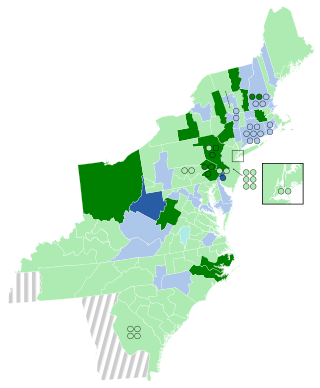
The 12th United States Congress was a meeting of the legislative branch of the United States federal government, consisting of the United States Senate and the United States House of Representatives. It met in Washington, D.C. from March 4, 1811, to March 4, 1813, during the third and fourth years of James Madison's presidency. The apportionment of seats in the House of Representatives was based on the 1800 United States census. Both chambers had a Democratic-Republican majority.

The 13th United States Congress was a meeting of the legislative branch of the United States federal government, consisting of the United States Senate and the United States House of Representatives. It met in Washington, D.C. from March 4, 1813, to March 4, 1815, during the fifth and sixth years of James Madison's presidency. The apportionment of seats in the House of Representatives was based on the 1810 United States census. Both chambers had a Democratic-Republican majority. The first two sessions were held at the Capitol building while the third, convened after the Burning of Washington, took place in the First Patent Building.
Ohio's at-large congressional district existed from 1803 to 1813, from 1913 to 1915, from 1933 to 1953 and from 1963 until 1967, when it was banned by the Voting Rights Act of 1965.
The 1814–15 United States House of Representatives elections were held on various dates in various states between April 26, 1814 and August 10, 1815. Each state set its own date for its elections to the House of Representatives before the first session of the 14th United States Congress convened on December 4, 1815. They occurred during President James Madison's second term. Elections were held for all 182 seats, representing 18 states.

The 1812–13 United States House of Representatives elections were held on various dates in various states between August 3, 1812 and April 30, 1813. Each state set its own date for its elections to the House of Representatives before the first session of the 13th United States Congress convened on May 24, 1813. They coincided with James Madison being re-elected president.

The 1810–11 United States House of Representatives elections were held on various dates in various states between April 24, 1810 and August 2, 1811. Each state set its own date for its elections to the House of Representatives before the first session of the 12th United States Congress convened on November 4, 1811. They occurred during President James Madison's first term. Elections were held for all 142 seats, representing 17 states.
Ohio's 2nd congressional district is a district in southern Ohio. It is currently represented by Republican Brad Wenstrup.
Ohio's 11th congressional district encompasses portions of Cuyahoga County in the Northeast part of the state—including all of Cleveland. It has been represented by Shontel Brown since 2021.

The 1810 United States House of Representatives elections in New York were held from April 24 to 26, 1810, to elect 17 U.S. Representatives to represent the State of New York in the United States House of Representatives of the 12th United States Congress. At the same time, a vacancy was filled in the 11th United States Congress.

The 1812 United States House of Representatives elections in New York were held from December 15 to 17, 1812, to elect 27 U.S. Representatives to represent the State of New York in the United States House of Representatives of the 13th United States Congress. At the same time, a vacancy was filled in the 12th United States Congress.

The 1814 United States House of Representatives elections in New York were held from April 26 to 28, 1814, to elect 27 U.S. Representatives to represent the State of New York in the United States House of Representatives of the 14th United States Congress.
Massachusetts gained three seats after the 1810 census, all of which were added to the District of Maine. Its elections were held November 5, 1812, but since Massachusetts law required a majority for election, which was not met in the 19th district, a second ballot was held there January 6, 1813.
Georgia gained two seats after the 1810 census.

Kentucky gained four seats after the 1810 census.

North Carolina gained one representative as a result of the census of 1810. Its elections were held April 30, 1813, after the term began but before Congress's first meeting.
A special election was held in Massachusetts's 17th congressional district on April 6, 1812 to fill the vacancy left by the resignation of Barzillai Gannett (DR) who resigned sometime in 1812 without having served.
A special election was held in New York's 6th congressional district December 15–17, 1812 to fill a vacancy left by the resignation of Robert Le Roy Livingston (F) on May 6, 1812
This page is based on this
Wikipedia article Text is available under the
CC BY-SA 4.0 license; additional terms may apply.
Images, videos and audio are available under their respective licenses.







